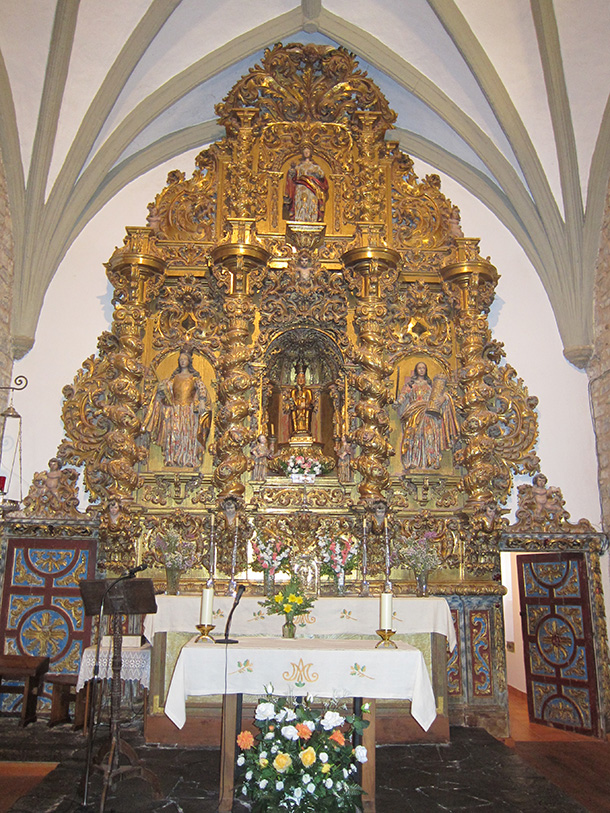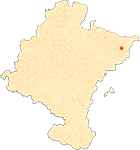Route through the Roncal altarpieces
By Ricardo Fernández Gracia
Altarpiece of the Shrine of Our Lady of Fair Love of the Virgin of the Castle of Roncal
In 1738, Francisco Pejón took over positionfor two altarpieces destined for the towns of Roncal and Burgui respectively. submitWhen the master was about to finish the altarpiece for the basilica of Nuestra Señora de San Salvador de Urzainqui, which was due to be completed on 1 March 1738, he contracted the altarpiece for the Virgen del Castillo in the town of Roncal. The deed of agreement was signed on 27 February with the patrons of the church of Nuestra Señora del Castillo, the mayor and aldermen of the town together with the church steward.
designLike their neighbours in Urzainqui, the people of Roncal considered that the old altarpiece no longer met the necessary conditions for the worship of the Virgin, and so they decided to commission the master Pejón, with whose modelhe would make the new altarpiece. The materials were to be paid for by the patrons, as was the payment of 2,000 reales. The survey of the work was entrusted to the master experts who would be appointed if necessary and, with regard to the deadlineexecution, it was only agreed that the master would start work as soon as possible, without stopping until it was finished.
The ground plan of the altarpiece is straight and its elevations include a sotabanco with carved work and lateral doors on the sides of the altarpiece, a bench with corbels incorporating busts of children, a single body divided into three sections and an attic between foliage flutings. The supports that articulate the central body and the attic compartment are dressed Solomonic columns, with chamfered sinuses and buds at the ends. The dadoes of the entablatures have been converted into cylinders and their corresponding cornices into semicircles, making this part of the altarpiece extraordinarily dynamic. A profuse decoration based on plant foliage covers the panels of the bench, the tops of the niches and the finials, and also extends to the attic and the bracelets of the main body. The cards that finish off the niche of the main figure and the crowning of the attic stand out for their designand execution of the relief. The iconography once again worships the saints of special devotion in the town. On either side of the patron saint, which is a beautiful Romanesque image from the second half of the 12th century, are the 18th-century sculptures of Santa Bárbara and Santa Orosia.
Parish archives of Garde, Vidángoz, Isaba, Uztárroz and Roncal.
file Diocesan of Pamplona. Processes
file General of Navarre. Roncal Notary's Office and Processes
ARDANAZ IÑARGA, N., La catedral de Pamplona en el siglo de las Luces. Arte, ceremonial y cultura, Pamplona, doctoral dissertation sustained at the University of Navarre, 2011. Vid. http://hdl.handle.net/10171/20480
BOLOQUI LARRAYA, B., Escultura zaragozana en la época de los Ramírez 1710-1780, Madrid, Ministerio de Cultura, 1983.
CHOCARRO HUESA, M., "El obispo Juan Rena, mediador y mecenas artístico de la catedral de Pamplona", Príncipe de Viana, 256 (2012), Issue dedicated to: programs of study sobre el Patrimonio Cultural y las artes en Navarra en torno a tres hitos 1212-1512-1812, (coordinated by Ricardo Fernández Gracia), pp. 587-601.
CLAVERÍA ARANGUA, J., Iconografía y santuarios de la Virgen en Navarra, vol. I, Madrid, Gráfica management assistant, 1942.
ECHEVERRÍA GOÑI, P., Polychromy of the Renaissance in Navarre, Pamplona, Government of Navarre, 1990.
GARCÍA GAÍNZA, M. C., Romanesque sculpture in Navarre. Disciples and followers of Juan de Anchieta, Pamplona, 1969.
GARCÍA GAÍNZA, M. C. et alt., Catalog Monumental de Navarra, IV* y IV**. Merindad de Sangüesa, Pamplona, Government of Navarra - Archbishopric of Pamplona - University of Navarra, 1989 and 1992.
FERNÁNDEZ GRACIA, R., El retablo barroco en Navarra, Pamplona, Government of Navarre, 2003.
FERNÁNDEZ GRACIA, R., "Los géneros escultóricos", El arte del Barroco en Navarra, (coord. R. Fernández Gracia), Pamplona, Gobierno de Navarra, 2014, pp. 175-271.
GÁRRIZ, J., La villa de Garde en el Valle del Roncal. essay de una monografía parroquial, Pamplona, Casa publishing house de G. Huarte, 1923.
HUALDE, F., "De cuando los Ezquer cruzaron el charco", Diario de Noticias de Navarra, 18 August 2008. http://patrimonionavarra2.blogspot.com.es/2010/09/18-de-agosto-de-2008.html
MORALES SOLCHAGA, E., "El gremio de San José y Santo Tomás de Pamplona hasta el siglo XVII", Príncipe de Viana, no. 239 (2006), pp. 791-860.
URANGA, J. E., Retablos navarros del Renacimiento, Pamplona, Institución Príncipe de Viana, 1947.












